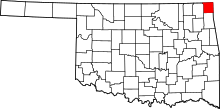Miami, Oklahoma
| Miami, Oklahoma | |
|---|---|
| City | |
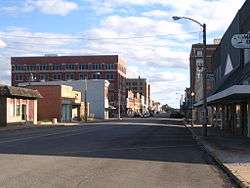 Downtown Miami (2008) | |
 Location within Ottawa County and Oklahoma | |
| Coordinates: 36°53′1″N 94°52′34″W / 36.88361°N 94.87611°WCoordinates: 36°53′1″N 94°52′34″W / 36.88361°N 94.87611°W[1] | |
| Country | United States |
| State | Oklahoma |
| County | Ottawa |
| Government | |
| • Mayor | Rudy Schultz |
| Area | |
| • Total | 9.8 sq mi (25.4 km2) |
| • Land | 9.7 sq mi (25.2 km2) |
| • Water | 0.1 sq mi (0.2 km2) |
| Elevation[1] | 797 ft (243 m) |
| Population (2010) | |
| • Total | 13,570 |
| • Estimate (2013) | 13,758 |
| • Density | 1,400/sq mi (530/km2) |
| Time zone | UTC-6 (CST) |
| • Summer (DST) | UTC-5 (CDT) |
| ZIP code | 74354-74355 |
| Area code | 539/918 |
| FIPS code | 40-48000[1] |
| GNIS feature ID | 1095343[1] |
| Website | Miami, Oklahoma |
Miami (/maɪˈæmˈʌ/ my-AM-uh)[2][3][4] is a city in and county seat of Ottawa County, Oklahoma, United States, founded in 1891.[1] Lead and zinc mining established by 1918, caused it to boom. It is the capital of the Miami Tribe of Oklahoma, after which it is named, the Modoc Tribe of Oklahoma, Ottawa Tribe of Oklahoma, Peoria Tribe of Indians and Shawnee Tribe. As of the 2010 census, it had 13,570 inhabitants a one percent decline since 2000.
History
Miami began in an unusual way, compared to other towns in Indian Territory. Per the Encyclopedia of Oklahoma History and Culture "... it was settled in a business-like way by men of vision who looked into the future and saw possibilities. It didn't just grow. It was carefully planned."[5]
W.C. Lykins petitioned the U.S. Congress to pass legislation on March 3, 1891 to establish the town. He met with Thomas F. Richardville, chief of the Miami Tribe of Oklahoma, who agreed to meet in turn with the U.S. Indian Commission and the Ottawa tribe. That meeting resulted in Congress authorizing the secretary of the Interior Department to approve the townsite purchase from the Ottawas. Lykins, Richardville and Manford Pooler, chief of the Ottawa, are identified in historical accounts as "fathers of Miami." Lykins' company, the Miami Town Company, bought 588 acres (238 ha) of land from the Ottawa for ten dollars an acre. On June 25–26, 1891 they held an auction of lots. In 1895, Miami incorporated and had more than 800 residents.[5]
The discovery of rich deposits of lead and zinc under Quapaw land a few miles north, caused Miami to boom. In 1907, at the time of statehood its population was 1,893, which increased as mining was established to 6,802 by 1920.[5]
It is the capital of the Miami Tribe of Oklahoma, after which it is named, the Modoc Tribe of Oklahoma, Ottawa Tribe of Oklahoma, Peoria Tribe of Indians and Shawnee Tribe.[6]
Geography
Miami is located near 36°53′1″N 94°52′34″W / 36.88361°N 94.87611°W (36.883539, −94.876018).[1] According to the United States Census Bureau, the city has a total area of 9.8 square miles (25 km2), of which 9.7 square miles (25 km2) is land and 0.1 square miles (0.26 km2) (0.82%) is water.
Demographics
| Historical population | |||
|---|---|---|---|
| Census | Pop. | %± | |
| 1900 | 1,527 | — | |
| 1910 | 2,907 | 90.4% | |
| 1920 | 6,802 | 134.0% | |
| 1930 | 8,064 | 18.6% | |
| 1940 | 8,345 | 3.5% | |
| 1950 | 11,801 | 41.4% | |
| 1960 | 12,869 | 9.1% | |
| 1970 | 13,880 | 7.9% | |
| 1980 | 14,237 | 2.6% | |
| 1990 | 13,142 | −7.7% | |
| 2000 | 13,704 | 4.3% | |
| 2010 | 13,570 | −1.0% | |
| Est. 2015 | 13,611 | [7] | 0.3% |
| Sources:[8][9][10][11][12][13] | |||
As of the 2010 census, there were 13,570 people, 5,315 households, and 3,337 families residing in the city.[14] a one percent decline from 13,704 at the 2000 census.[15] The population density was 1,258.7 people per square mile (485.9/km²).[14] The racial makeup of the city was 68.9% white, 1.3% African American, 17.1% Native American, 0.5% Asian, 2% Pacific Islander, 2.1% from other races, and 8% from two or more races.[14] Hispanic or Latino of any race made up 4.8% of the population.[14]
There were 5,315 households out of which 31.9% had children under the age of 18 living with them, 44.6% were married couples living together, 15% had a female householder with no husband present, and 36.2% were non-families.[16] Single individuals living alone accounted for 31.9% of households and individuals 65 years of age or older living alone accounted for 14.7% of households.[16] The average household size was 2.46 and the average family size was 3.07.[16]
In the city, the population was spread out with 24.7% under the age of 18, 57.1% from 18 to 64, and 18.2% who were 65 years of age or older.[16] The median age was 35.8 years.[16] The population was 53.2% female and 46.8% male.[16]
The median income for a household in the city was $34,561, and the median income for a family was $42,313.[16] Males had a median income of $32,699 versus $25,320 for females.[16] About 14.2% of families and 19.2% of the population were below the poverty line.[16]
Government
Local government in Miami consists of a Mayor and four councilmen representing four Wards.
- Mayor – Rudy Schultz
- Ward One Councilman – Brian Forrester
- Ward Two Councilman – Doug Weston
- Ward Three Councilman – Ryan Orcutt[17]
- Ward Four Councilman – Vicki Lewis[17]
As of 2015, the city is represented in the Oklahoma House of Representatives by Democrat Ben Loring,[18] and in the Oklahoma Senate by Democrat Charles Wyrick. The city lies within Oklahoma's 2nd congressional district, represented by Markwayne Mullin since 2013.
Coleman Theatre
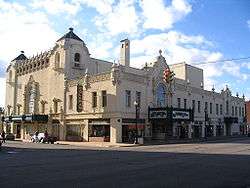
Miami is home to the historic Coleman Theatre, located at 103 N. Main St.
On April 18, 1929, the 1600 seat Coleman Theatre enjoyed a festive grand opening. Designed by the Boller Bros. Architectural Firm, Kansas City, Missouri, built by George L. Coleman Sr. at a cost of $600,000, the elegant Louis XV interior includes gold leaf trim, silk damask panels, stained glass panels, marble accents, a carved mahogany staircase, Wurlitzer pipe organ, decorative plaster moldings, and bronze railings. In 1983 the Coleman Theatre was placed on the National Register of Historical Places. A local non-profit community group, Miami Little Theatre, established in 1959, performs five, large-scale productions on the Coleman stage every year.
Education
Public schools are managed by the Miami Public Schools school district.[19] The high school is Miami High School, whose mascot is the Wardog. The Wardog is a mascot unique to Miami and has not been adopted as a mascot by any other school in the United States.[20]
Northeastern Oklahoma A&M College (NEO) was initially accredited in 1925 by the North Central Association of Colleges and Schools. It is a two-year community college with about 2,000 students.[21]
Notable people
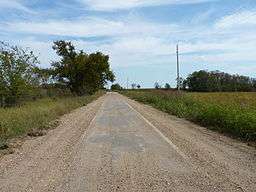
- Steve Owens – The 1969 Heisman Trophy winner
- Charles Banks Wilson – artist
- Keith Anderson – musician
- Carol Littleton – film editor
- Steve Gaines – musician
- Cassie Gaines – singer
- David Froman – Actor[22]
- Charles R. Nesbitt – civil servant
- Moriss Taylor - Singer/TV Host
Gallery
 Interior of the Coleman Theatre
Interior of the Coleman Theatre Clock and bench in Downtown, Miami, OK
Clock and bench in Downtown, Miami, OK Coleman Theater in downtown Miami, OK, at night
Coleman Theater in downtown Miami, OK, at night Original Wurlitzer organ in the Coleman Theater
Original Wurlitzer organ in the Coleman Theater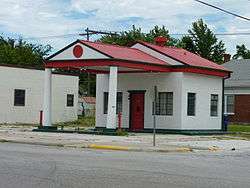 Former Miami Marathon Oil Company service station. Building was last used as a salon.
Former Miami Marathon Oil Company service station. Building was last used as a salon.
See also
References
- 1 2 3 4 5 6 "GNIS Detail - Miami". geonames.usgs.gov. Retrieved April 9, 2018.
- ↑ "Facts for Kids: Miami Indians (Miamis)". www.bigorrin.org. Retrieved April 9, 2018.
- ↑ "Indian History at Hicksville-Ohio.com". www.hicksville-ohio.com. Retrieved April 9, 2018.
- ↑ "Archived copy". Archived from the original on May 9, 2008. Retrieved December 7, 2008.
- 1 2 3 Jess Heck,"Miami." Encyclopedia of Oklahoma History and Culture. Velma Nieberding, History of Ottawa County Retrieved October 21, 2013.
- ↑ Oklahoma Indian Affairs Commission. Oklahoma Indian Nations Pocket Pictorial Archived February 11, 2009, at the Wayback Machine.. 2008.
- ↑ "Annual Estimates of the Resident Population for Incorporated Places: April 1, 2010 to July 1, 2015". Archived from the original on June 2, 2016. Retrieved July 2, 2016.
- ↑ "Population-Oklahoma" (PDF). U.S. Census 1910. U.S. Census Bureau. p. 161. Retrieved November 22, 2013.
- ↑ "Population-Oklahoma" (PDF). 15th Census of the United States. U.S. Census Bureau. Retrieved November 27, 2013.
- ↑ "Number of Inhabitants: Oklahoma" (PDF). 18th Census of the United States. U.S. Census Bureau. Retrieved November 22, 2013.
- ↑ "Oklahoma: Population and Housing Unit Counts" (PDF). U.S. Census Bureau. Retrieved November 22, 2013.
- ↑ "American FactFinder". United States Census Bureau. Retrieved 2008-01-31.
- ↑ "Incorporated Places and Minor Civil Divisions Datasets: Subcounty Population Estimates: April 1, 2010 to July 1, 2012". U.S. Census Bureau. Archived from the original on June 17, 2013. Retrieved November 25, 2013.
- 1 2 3 4 United States Census Demographic Profile of Miami, Oklahoma, at American FactFinder (cite does not allow direct link). (accessed September 5, 2013)
- ↑ CensusViewer:Miami, Oklahoma Population. Retrieved October 21, 2013.
- 1 2 3 4 5 6 7 8 9 2007–2011 American Community Survey 5-Year Estimates for Miami, Oklahoma, at American FactFinder (cite does not allow direct link). (accessed September 5, 2013)
- 1 2 "City Council / Mayor | Miami, OK - Official Website". www.miamiokla.net. Retrieved 2018-10-07.
- ↑ Representative Ben Loring-Oklahoma House of Representatives Archived October 28, 2015, at the Wayback Machine.
- ↑ "Miami Public Schools - Miami High School". miami.k12.ok.us. Retrieved April 9, 2018.
- ↑ "History of the Wardog". wardogathletics.com. Retrieved July 11, 2018.
- ↑ "Northeastern A&M College home page". neo.edu. Archived from the original on February 2, 2015. Retrieved April 9, 2018.
- ↑ "Miami Little Theatre". Retrieved 2010-02-10.
External links
| Wikimedia Commons has media related to Miami, Oklahoma. |
| Wikivoyage has a travel guide for Miami, Oklahoma. |
